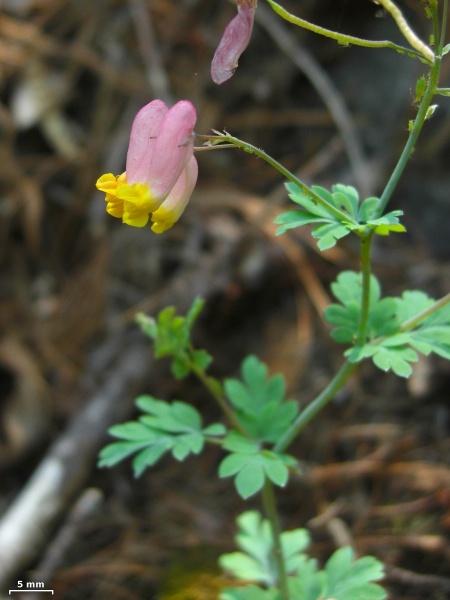
Source: Jason Hollinger
Capnoides sempervirens
Pink Corydalis
Corydale toujours verte
Synonyms
harlequin flower
pale corydalis
pink and yellow corydalis
rock harlequin
corydale toujours-verte
corydalis pâle
corydalis toujours verte
No seeds available for this plant.
We currently accept seeds for this plant
Bloom Colour: Pink
Bloom Period: Jun - Aug
Max Height: 3.0 feet
Max Width: 2.0 feet
Light Condition:
 More than 6 hours of direct sun a day
More than 6 hours of direct sun a day
 More than 2 or 3 hours but less than 6 hours of direct sun a day
Soil conditions:
More than 2 or 3 hours but less than 6 hours of direct sun a day
Soil conditions:
 Tolerates dry soil condition
Tolerates dry soil condition
 More than 6 hours of direct sun a day
More than 6 hours of direct sun a day
 More than 2 or 3 hours but less than 6 hours of direct sun a day
More than 2 or 3 hours but less than 6 hours of direct sun a day
 Tolerates dry soil condition
Tolerates dry soil condition
Lifespan:
Annual
plants that have a lifespan of one year
Gardener Experience:
 Does not spread uncontrollably
Does not spread uncontrollably
 Easy to germinate
Easy to germinate
 Self-seeding
Self-seeding
 Does not spread uncontrollably
Does not spread uncontrollably
 Easy to germinate
Easy to germinate
 Self-seeding
Self-seeding
Landscape Uses:
 Suitable for rock gardens
Suitable for rock gardens
 Suitable for container garden
Suitable for container garden
 Suitable for school gardens
Suitable for school gardens
 Suitable for rock gardens
Suitable for rock gardens
 Suitable for container garden
Suitable for container garden
 Suitable for school gardens
Suitable for school gardens
Ecological Benefits:
 Butterfly host
Butterfly host
 Butterfly host
Butterfly host
Tolerates:
Special Features and Considerations:
 This plant is a GRASP candidate
This plant is a GRASP candidate
 This plant is a GRASP candidate
This plant is a GRASP candidate
Plant Location
Native to Ottawa region: Yes
Distribution according to VASCAN

Ephemeral
Native
Introduced
Excluded
Extirpated
Doubtful
Absent
Thrives in Ecozones
- Taiga Plains
- Taiga Shield
- Boreal Plains
- Mixed Wood Plains
Ecological Benefits
Butterflies Supported by Capnoides sempervirens
No butterfly data available for this plant.
Specialized Bees Supported by Capnoides sempervirens
No bee data available for this plant.
Plants that grow in similar conditions, that bloom at the same time.
Complementary Plants
- Allium stellatum
Autumn Onion
Ail étoilé - Drymocallis arguta
Tall Wood Beauty
Potentille âcre - Eragrostis spectabilis
Purple Lovegrass
Éragrostide brillante - Liatris cylindracea
Slender Blazing Star
Liatris cylindrique - Monarda punctata
Spotted Beebalm
Monarde ponctuée
Substitute For Non-Native Plants
- Lamprocapnos spectabilis (Bleeding hearts)
- Phlox subulata (Moss Phlox)
Sowing Information
Download Seed Envelope Labels (PDF)
- Sowing depth: Sow just below surface
- Sow by March
- Stratification duration: 30 days
- Self-seeding
Harvesting and Seed Sharing
- Harvest start month: May
- Harvesting indicator:
- Pods are slightly open and seeds inside are dark
- Harvesting:
- Open the pod, remove seeds
- Seed viability test:
- No test needed before donating
- Packaging measure: 1 rounded 1/32 teaspoon
- Seed storage:
- Air dry in paper bag or open container, for a few days until crisp
- Shake seeds to move them once in a while to prevent molding
- Cultivar: No, you can donate without knowing the source as there are only straight species
- Remove non-seed material
- No harvesting video available at this time.
Toxicity Notes
Inadequate information on toxicity found.
GRASP Candidate
Overlooked or difficult to grow plants (eg ghost plants, shrubs, trees, complicated germination etc); sapling sitters, seed sitters, skilled germination, growers with right conditions- aiming for local stock; these plants may not be extinct, but overlooked OR support habitat OR support a vulnerable animal/insect.


 Canadensis
Canadensis
